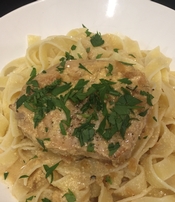 versatile dish that is also unusually wine friendly.
versatile dish that is also unusually wine friendly.
“Dijonnaise” refers to the Burgundian town of Dijon and hence to the mustard that was produced here since the Middle Ages. The mustard is reportedly no longer made in Dijon but in a neighboring town, and most of the mustard seeds themselves come from Canada. I am a little saddened to think that this beloved condiment is no longer produced in Dijon, but after a lifetime of enjoying it, I’ll admit I don’t find that the delicious mustard tastes any different today.
Pork Chops Dijonnaise
Serves 4
The chops may be served with rice, pasta, smashed potatoes or pureed lima beans. If you want to serve them over pasta or rice, include one full cup instead of ½ cup of chicken stock.
4 boneless, skinless pork chops, about 1 inch thick
One tablespoon olive oil
½ cup minced onions
½ to one cup white wine
½ cup chicken stock, or one cup for serving the dish over pasta
¼ whipping cream
2 tablespoons Dijon mustard (or more, to taste)
One tablespoon minced parsley for garnish
Pat the pork chops dry on both sides with a paper towel. Salt and pepper them on both sides. Heat the olive oil in a heavy skillet. When the oil is hot, sear the pork chops on both sides until they have browned, about 3-5 minutes per side. Transfer them to a dish.
Add the onions to the skillet and cook over medium heat, stirring frequently, until they are lightly colored and have softened. Pour in half the wine, raise the heat, and cook, stirring frequently, until the liquid is reduced by almost half, about 1-2 minutes. Pour in the chicken stock along with the remaining wine. Cook over medium heat for about 5 minutes, then whisk in the cream and the mustard. Add the pork chops and any of their juices that have accumulated. Simmer, uncovered, for about 5 minutes or until the internal temperature of the chops has reached 145°.
The Wines: It is somehow satisfying to feature a dish every once in awhile that partners beautifully with a variety of wines, and Pork Chops Dijonnais is one of those recipes. The wines that did not fare well here were, first, a big, tannic, oaky red that overwhelmed the soft, creamy sauce. A tart Sauvignon Blanc didn’t fare well either. I’ve liked this type of refreshing white wine with other dishes, but in this case, its relatively high acidity got screechy in the company of the comparatively rich, mellow mustard sauce. But these three paired up very nicely:
Chappellet, Russian River Valley (Sonoma County, California) Pinot Noir Bateman Vineyard “Grower Collection, Two Blocks” 2017 ($60): Like the very best Pinots, this one offers both power and delicacy (the “iron fist in a velvet glove”). This flexibility is why the wine accords beautifully with both the meatiness of the pork chops and the relative delicacy of the creamy mustard sauce.
MacRostie Winery and Vineyards, Sonoma Coast (Sonoma County, California) Chardonnay 2018 ($25): Like the Chappellet Pinot Noir, this luscious Chardonnay is lithe and versatile. Its creamy texture, zesty fruit flavors and minerality all wrap deliciously around the taste and texture of the racy sauce.
Oyster Bay, Marlborough (New Zealand) Rosé, 2019 ($14): A charming, fragrant, dry and refreshing rosé, this wine also has the structure and depth of flavor to hold up to the relative complexity of the pork and its sauce. This Pinot Noir-based rosé has invigorating yet balanced acidity that maximizes the relationship between the wine and food.
